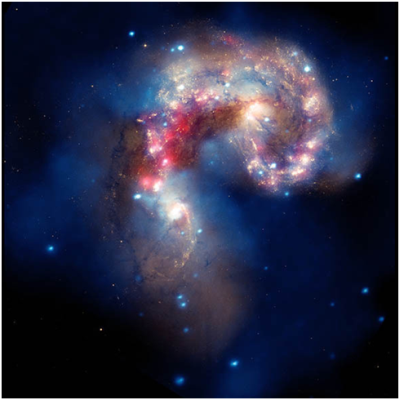21 August 2010

Credit: NASA/CXC/SAO/JPL-Caltech/STScI
NASA recently released a new image of a fascinating cosmic wonder, two beautiful galaxies in an on-going collision, known as the Antennae Galaxies. In wide-angle images, the Antennae Galaxies show long, antenna-like arms of stars, dust and gas, emanating from the galaxies, as a result of the gravitational interaction of the pair. This violent galactic encounter has also triggered an active process of star formation in both galaxies.
The image has been produced by combining images acquired by three of NASA’s space observatories: the Chandra X-ray Observatory (CXO), the Hubble Space Telescope (HST), and the Spitzer Space Telescope (SST). The colors in the image are not true, but they represent the different observations of the space-based telescopes. Blue highlights CXO’s X-ray data. HST’s observations appear in gold and brown, while SST’s data are coded in red.
The Antennae are located about 62 million light-years away. The dramatic collision started over 100 million years ago, a short period by the estimated time scale of the universe. It has induced the formation of millions of stars, in the two galaxies. The most massive of these young stars have rapidly burned the nuclear fuel in their cores, and exploded, releasing tremendous amounts of energy. These titanic stellar explosions are termed supernovae.

A wide-angle view of the Antennae Galaxies, showing their antenna-like arms
Credit: NASA
The X-ray image from CXO shows large clouds of hot, interstellar gas, which have been enriched with chemical elements, including oxygen, iron, magnesium and silicon. These elements have been synthesized within the progenitor stars of the supernovae.
The bright, point sources in the image are due to material falling onto small, extremely dense objects, black holes and neutron stars that are remnants of the massive exploding stars. Some of these black holes are estimated to be 100 times more massive than the Sun.
The SST data reveal infrared emission from warm clouds of cosmic dust that have been heated by young stars, with the brightest clouds lying in the region between the two galaxies. The HST data show evolved stars and star-forming regions in gold and white, while filaments of dust appear in brown. Many of the fainter objects in the optical image are clusters containing thousands of stars.
Further Reading
HST
http://hubblesite.org/
CXO
http://chandra.harvard.edu/photo/chronological.html
SST
http://www.spitzer.caltech.edu/
Aymen Mohamed Ibrahem
Senior Astronomy Specialist